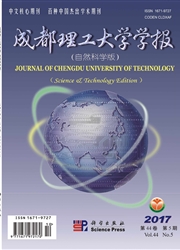

 中文摘要:
中文摘要:
利用高分辨率层序地层学的理论,结合测井、岩心、岩石薄片、沉积相及前人研究成果,重点研究鄂尔多斯盆地大牛地气田石炭系太原组第二段层序格架下障壁砂坝砂体演化及其物性特征。结果表明:太二段整体处于基准面下降沉积时期,经历了多次短期基准面旋回变化。受短期基准面旋回变化的影响,太二段内形成了进积、加积、退积3种类型的障壁砂坝。不同类型障壁砂坝的骨架颗粒及成岩强度具有一定的差异性,进积、加积型障壁砂坝较退积型障壁砂坝残留原生孔隙多,所受破坏性成岩作用弱,建设性成岩作用强,储层物性好;受控于中、长期基准面旋回下降的影响,太二段整体是一个“进积”的过程,水动力条件和建设性成岩作用增强,破坏性成岩作用减弱,物性由下至上逐渐变好。综合多级基准面旋回变化的影响,太二段晚期进积型、加积型障壁砂坝为优势储层分布区域。
 英文摘要:
英文摘要:
Based on the theory of high resolution sequence stratigraphy, combined with logging, drilling core data, thin section, sedimentary facies, the evolution of barrier bar sand body and reservoir property under the sequence stratigraphic framework in the area of Carboniferous Taiyuan Group 2 Formation in Daniudi gas field, Ordos Basin is studied. It shows that the Member 2 of Taiyuan Formation formed under the condition of datum level descending and experienced a number of short-term base level cycle changes during this period. Affected by the short-term base level cycle changes, the Member 2 of Taiyuan Formation formed three kinds of barrier bars of progradation, aggradation and retrograding. Different types of barrier bars possess different particle size and diagenesis intensity. Progradation and aggradation barrier bars have more primary pore, and its reservoir property is better with a strong constructive diagenesis and a weak destructive diagenesis than the reservoir property of retrograding barrier bar. Influenced by medium, long-term base-level decline, the reservoir of barrier bars in the Member 2 of Taiyuan Formation as a whole show a trend of progradation process with enhanced hydrodynamic conditions, constructive diagenesis, weak destructive diagenesis. Analysis of multistage base level cycle changes shows that progradation and aggradation barrier bars in the Member 2 of Taiyuan Formation is the favorable reservoir distribution area.
 同期刊论文项目
同期刊论文项目
 同项目期刊论文
同项目期刊论文
 期刊信息
期刊信息
